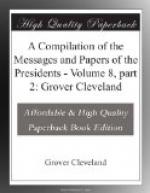From a purely commercial point of view the completion of such a waterway opens a most favorable prospect for the future of our country. The nations of the Pacific coast of South America will by its means be brought into close connection with our Gulf States. The relation of those American countries to the United States is that of a natural market, from which the want of direct communication has hitherto practically excluded us. By piercing the Isthmus the heretofore insuperable obstacles of time and sea distance disappear, and our vessels and productions will enter upon the world’s competitive field with a decided advantage, of which they will avail themselves.
When to this is joined the large coasting trade between the Atlantic and Pacific States, which must necessarily spring up, it is evident that this canal affords, even alone, an efficient means of restoring our flag to its former place on the seas.
Such a domestic coasting trade would arise immediately, for even the fishing vessels of both seaboards, which now lie idle in the winter months, could then profitably carry goods between the Eastern and the Western States.
The political effect of the canal will be to knit closer the States now depending upon railway corporations for all commercial and personal intercourse, and it will not only cheapen the cost of transportation, but will free individuals from the possibility of unjust discriminations.
It will bring the European grain markets of demand within easy distance of our Pacific States, and will give to the manufacturers on the Atlantic seaboard economical access to the cities of China, thus breaking down the barrier which separates the principal manufacturing centers of the United States from the markets of the vast population of Asia, and placing the Eastern States of the Union for all purposes of trade midway between Europe and Asia. In point of time the gain for sailing vessels would be great, amounting from New York to San Francisco to a saving of seventy-five days; to Hongkong, of twenty-seven days; to Shanghai, of thirty-four days, and to Callao, of fifty-two days.
Lake Nicaragua is about 90 miles long and 40 miles in greatest width. The water is fresh, and affords abundant depth for vessels of the deepest draft. Several islands give facilities for establishing coaling stations, supply depots, harbors, and places for repairs. The advantage of this vast inland harbor is evident.
The lake is 110 feet above tide water. Six locks, or five intermediate levels, are required for the Pacific end of the canal. On the Atlantic side but five locks, or four intermediate levels, are proposed. These locks would in practice no more limit the number of vessels passing through the canal than would the single tide lock on the Pacific end, which is necessary to any even or sea-level route.
Seventeen and a half miles of canal lie between the Pacific and the lake. The distance across the lake is 56 miles, and a dam at the mouth of the San Carlos (a tributary of the San Juan), raising the water level 49 feet, practically extends the lake 63 miles to that point by a channel from 600 to 1,200 feet wide, with an abundant depth of water.




